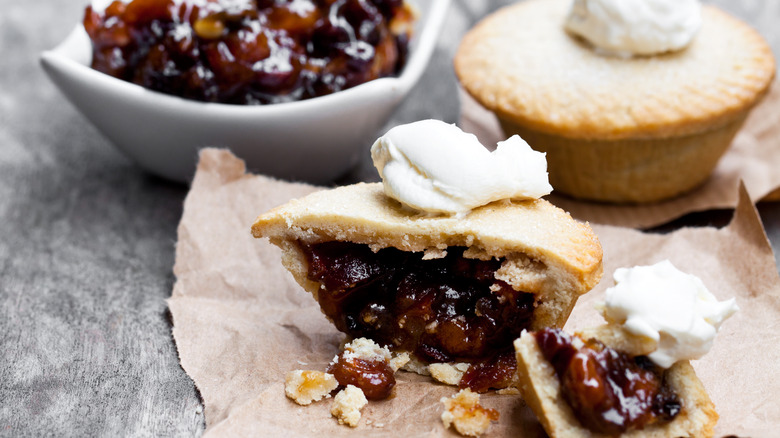Mincemeat Tongue Pie Was A Luxury On Colonial Thanksgiving Tables
Recipes go in and out of fashion. Some are simply made less frequently — think layered Jell-O molds — and some are long forgotten, like mincemeat tongue pie. Once a decadent Thanksgiving dish, mincemeat tongue pie has gone the way of the wood-burning stove.
Mincemeat, according to Farmers' Almanac, historically refers to meat that has been preserved with sugar and alcohol. Smoke and salt are not used to preserve the meat. As mincemeat recipes became more standardized throughout the 1400s, 1500s, and 1600s, they came to include finely diced meat, a mixture of fruits (often dried), plus wine or some kind of vinegar. Today, the liquor generally used to make mincemeat pie is brandy, which along with other distilled spirits, replaced wine and vinegar by the 1700s, according to Farmers' Almanac. It wasn't until the Victorian period (1837 to 1901) that mincemeat became associated with upscale Christmas meals.
In the past century, mincemeat has remained a part of the Christmas tradition in England, but nowadays the meat has been replaced with fruit and brandy, per Food Network. Apples, candied citrus peel, raisins, sugar, and brandy are most commonly found in Britain's holiday mincemeat pies, as well as cinnamon, ginger, allspice, and nutmeg. Mincemeat is still consumed in the United States, but the recipe has been adapted to include fresh and dried cranberries, walnuts or almonds, dried currants, dates, and perhaps meat, such as beef, lamb, chicken, or beef suet. For a meatless version of mincemeat, use butter instead of suet, according to Food Network.
A hearty recipe
Originally used as a way to use up bits of leftover meat or other unused ingredients, such as organ meat, mincemeat pie evolved into a dish that was not cheap to make with its use of pricier ingredients like a third of a pound of sugar, a quarter pound of butter, a pint of wine, and a pound of raisins, according to Atlas Obscura. Both the meat and the fruit were expensive, according to Food Network, making it a dish off limits for some people.
While considered a Christmas dish in England, mincemeat pies were more often served as a luxury for Thanksgiving in America, according to Atlas Obscura. In the oldest American cookbook dating to the colonial period, "American Cookery," three recipes for mincemeat pie are provided, one of which calls for the particularly indulgent ingredients cow feet and cow tongue. The process of making mincemeat pie also helped to preserve the meat because of the use of sugar and alcohol (via Food Network). The meat used for mincemeat pies was boiled and then finely chopped, per Our Heritage of Health. During the 20th century, the beef tongue was swapped for fruits in mincemeat and the pies were also downsized, now commonly the size of a cupcake for individual servings, according to Food Network.
As people's tastes changed, so did what they ate. Once an upscale, but essential part of holiday dinners in the United States and England, mincemeat tongue pie would surely be a notable and unexpected addition to a Thanksgiving dinner today.

